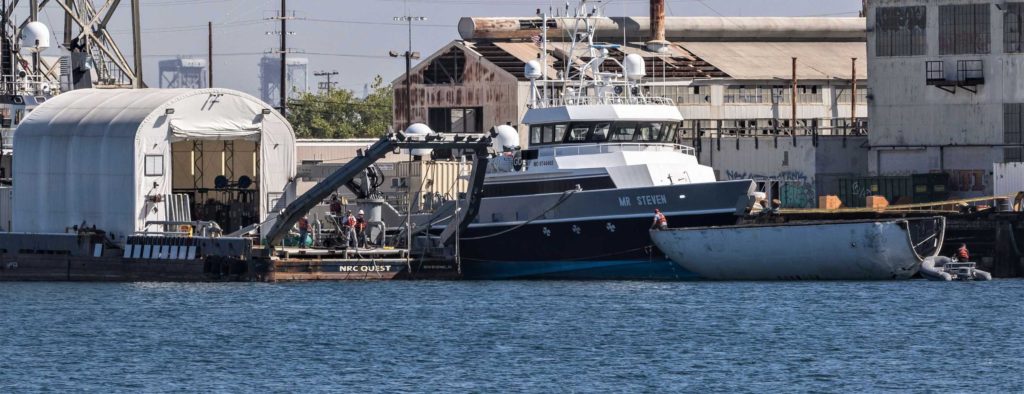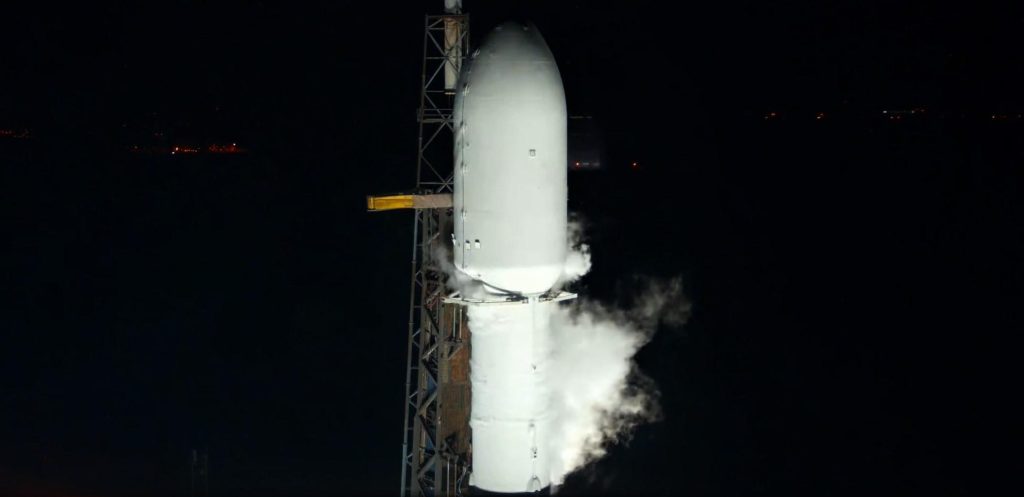

News
SpaceX Falcon 9 rocket completes 50th orbital launch of 2022
SpaceX has successfully launched French satellite communications provider Eutelsat’s Hotbird 13G satellite, chipping away at a jam-packed November manifest and completing Falcon 9’s 50th launch of 2022.
The company’s workhorse rocket lifted off from its Cape Canaveral Space Force Station (CCSFS) LC-40 pad with the 4.5-ton (~9,900 lb) geostationary communications satellite in tow at 1:22 am EDT on November 3rd – 116 minutes later than originally planned to leave more time “to complete pre-flight checkouts.” But Falcon 9 performed flawlessly, growing a record-breaking streak with its 160th consecutively-successful launch.
Flying for the seventh time since it debuted in June 2021 and just 45 days after its sixth flight, Falcon 9 booster B1067 completed a nominal ascent, separation, descent, reentry, and landing. The booster touched down on SpaceX drone ship Just Read The Instructions (JRTI) about nine minutes after liftoff and will be prepared for an eighth launch in the near future – possibly as early as next month. In addition to its well-known booster reuse, SpaceX’s webcast host noted that Falcon 9’s payload fairing – a carbon fiber composite nosecone made up of two separable halves – had halves flying for the fourth and sixth time.
Speaking in 2017, SpaceX CEO Elon Musk once likened each Falcon fairing half to a pallet of $3 million that falls into the ocean after every launch. Around the same time, SpaceX decided to try to recover that pallet of cash, kicking off its fairing recovery and reuse program. Five years later, Falcon fairing reuse – while far less visible and famous than booster reuse – has become extremely reliable. At its current rate of one launch every six days, recovering and reusing fairings likely saves SpaceX tens or even hundreds of millions of dollars annually and limits the need for major manufacturing expansions that would otherwise be necessary.
Even though SpaceX fishes fairing halves out of the ocean before every flight, the company’s cleaning and refurbishment processes have improved to the point that even paying customers have started to accept flight-proven fairings on their launches. Eutelsat’s Hotbird 13G satellite is the first customer payload to use a Falcon fairing half for the sixth time, further raising the bar of acceptance.


About half an hour after liftoff, Falcon 9’s expendable upper stage separated from Hotbird 13G. On October 15th, a different Falcon 9 rocket launched its twin, Hotbird 13F, into a supersynchronous transfer orbit measuring around 400 kilometers (~245 mi) by 56,000 kilometers (~34,800 mi). Launching a satellite to a transfer orbit with an apogee higher than its destination makes reaching a circular orbit at that target altitude (35,800 km, in this case) faster and easier. Having to do less work to raise its orbit will leave Hotbird 13F and 13G with more fuel than they would otherwise have, effectively extending their theoretical lifespans by preserving more propellant for orbit maintenance after it reaches GEO.
Hotbird 13G was SpaceX’s 51st launch of 2022 and 59th launch in 365 days. If SpaceX sustains the average pace it has set in the last ten months through the last two months of 2022, it could end the year having launched more than 60 times. The mission was also Falcon 9’s 50th launch of 2022, solidifying its spot as the most-launched rocket in a calendar year. The record for the most successful launches (61) of the same rocket family in one year, however, was set by the Soviet Union and has stood for more than four decades.
SpaceX has at least five more Falcon 9 launches tentatively scheduled this month. Intelsat Galaxy 31 & 32 satellites are up next and could launch from the same pad as Hotbird 13G as early as November 8th, followed by Eutelsat 10B in mid-November, and Japanese startup ispace’s first Moon lander no earlier than November 22nd. An uncrewed Dragon spacecraft is set to launch NASA cargo to the the International Space Station (ISS) on November 20th. Finally, while tentative and contingent upon three other launches going smoothly, SpaceX could squeeze in Starlink 4-37 in late November.

News
Tesla starts showing how FSD will change lives in Europe
Local officials tested the system on narrow country roads and were impressed by FSD’s smooth, human-like driving, with some calling the service a game-changer for everyday life in areas that are far from urban centers.

Tesla has launched Europe’s first public shuttle service using Full Self-Driving (Supervised) in the rural Eifelkreis Bitburg-Prüm region of Germany, demonstrating how the technology can restore independence and mobility for people who struggle with limited transport options.
Local officials tested the system on narrow country roads and were impressed by FSD’s smooth, human-like driving, with some calling the service a game-changer for everyday life in areas that are far from urban centers.
Officials see real impact on rural residents
Arzfeld Mayor Johannes Kuhl and District Administrator Andreas Kruppert personally tested the Tesla shuttle service. This allowed them to see just how well FSD navigated winding lanes and rural roads confidently. Kruppert said, “Autonomous driving sounds like science fiction to many, but we simply see here that it works totally well in rural regions too.” Kuhl, for his part, also noted that FSD “feels like a very experienced driver.”
The pilot complements the area’s “Citizen Bus” program, which provides on-demand rides for elderly residents who can no longer drive themselves. Tesla Europe shared a video of a demonstration of the service, highlighting how FSD gives people their freedom back, even in places where public transport is not as prevalent.
What the Ministry for Economic Affairs and Transport says
Rhineland-Palatinate’s Minister Daniela Schmitt supported the project, praising the collaboration that made this “first of its kind in Europe” possible. As per the ministry, the rural rollout for the service shows FSD’s potential beyond major cities, and it delivers tangible benefits like grocery runs, doctor visits, and social connections for isolated residents.
“Reliable and flexible mobility is especially vital in rural areas. With the launch of a shuttle service using self-driving vehicles (FSD supervised) by Tesla in the Eifelkreis Bitburg-Prüm, an innovative pilot project is now getting underway that complements local community bus services. It is the first project of its kind in Europe.
“The result is a real gain for rural mobility: greater accessibility, more flexibility and tangible benefits for everyday life. A strong signal for innovation, cooperation and future-oriented mobility beyond urban centers,” the ministry wrote in a LinkedIn post.
News
Tesla China quietly posts Robotaxi-related job listing
Tesla China is currently seeking a Low Voltage Electrical Engineer to work on circuit board design for the company’s autonomous vehicles.

Tesla has posted a new job listing in Shanghai explicitly tied to its Robotaxi program, fueling speculation that the company is preparing to launch its dedicated autonomous ride-hailing service in China.
As noted in the listing, Tesla China is currently seeking a Low Voltage Electrical Engineer to work on circuit board design for the company’s autonomous vehicles.
Robotaxi-specific role
The listing, which was shared on social media platform X by industry watcher @tslaming, suggested that Tesla China is looking to fill the role urgently. The job listing itself specifically mentions that the person hired for the role will be working on the Low Voltage Hardware team, which would design the circuit boards that would serve as the nervous system of the Robotaxi.
Key tasks for the role, as indicated in the job listing, include collaboration with PCB layout, firmware, mechanical, program management, and validation teams, among other responsibilities. The role is based in Shanghai.
China Robotaxi launch
China represents a massive potential market for robotaxis, with its dense urban centers and supportive policies in select cities. Tesla has limited permission to roll out FSD in the country, though despite this, its vehicles have been hailed as among the best in the market when it comes to autonomous features. So far, at least, it appears that China supports Tesla’s FSD and Robotaxi rollout.
This was hinted at in November, when Tesla brought the Cybercab to the 8th China International Import Expo (CIIE) in Shanghai, marking the first time that the autonomous two-seater was brought to the Asia-Pacific region. The vehicle, despite not having a release date in China, received a significant amount of interest among the event’s attendees.
Elon Musk
Elon Musk and Tesla AI Director share insights after empty driver seat Robotaxi rides
The executives’ unoccupied tests hint at the rapid progress of Tesla’s unsupervised Robotaxi efforts.

Tesla CEO Elon Musk and AI Director Ashok Elluswamy celebrated Christmas Eve by sharing personal experiences with Robotaxi vehicles that had no safety monitor or occupant in the driver’s seat. Musk described the system’s “perfect driving” around Austin, while Elluswamy posted video from the back seat, calling it “an amazing experience.”
The executives’ unoccupied tests hint at the rapid progress of Tesla’s unsupervised Robotaxi efforts.
Elon and Ashok’s firsthand Robotaxi insights
Prior to Musk and the Tesla AI Director’s posts, sightings of unmanned Teslas navigating public roads were widely shared on social media. One such vehicle was spotted in Austin, Texas, which Elon Musk acknowleged by stating that “Testing is underway with no occupants in the car.”
Based on his Christmas Eve post, Musk seemed to have tested an unmanned Tesla himself. “A Tesla with no safety monitor in the car and me sitting in the passenger seat took me all around Austin on Sunday with perfect driving,” Musk wrote in his post.
Elluswamy responded with a 2-minute video showing himself in the rear of an unmanned Tesla. The video featured the vehicle’s empty front seats, as well as its smooth handling through real-world traffic. He captioned his video with the words, “It’s an amazing experience!”
Towards Unsupervised operations
During an xAI Hackathon earlier this month, Elon Musk mentioned that Tesla owed be removing Safety Monitors from its Robotaxis in Austin in just three weeks. “Unsupervised is pretty much solved at this point. So there will be Tesla Robotaxis operating in Austin with no one in them. Not even anyone in the passenger seat in about three weeks,” he said. Musk echoed similar estimates at the 2025 Annual Shareholder Meeting and the Q3 2025 earnings call.
Considering the insights that were posted Musk and Elluswamy, it does appear that Tesla is working hard towards operating its Robotaxis with no safety monitors. This is quite impressive considering that the service was launched just earlier this year.








